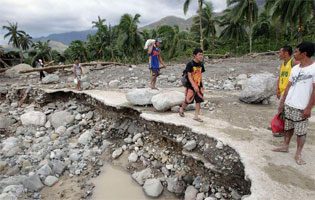Oxfam and its humanitarian partners in the Philippines, the Humanitarian Response Consortium, or HRC, have begun an emergency response targeting communities hardest-hit by Typhoon Bopha (known locally as Pablo) on the southern island of Mindanao.
Oxfam and its humanitarian partners in the Philippines, the Humanitarian Response Consortium, or HRC, have begun an emergency response targeting communities hardest-hit by Typhoon Bopha (known locally as Pablo) on the southern island of Mindanao.
Key priorities including getting clean, safe drinking water to disaster-hit areas, establishing basic sanitation facilities and providing cash and starting cash-for-work projects to help families buy food, clothing and other shelter needs.
 Water treatment supplies and hygiene kits are being sent to the worst-hit areas in Compostela Valley and Davao Oriental provinces, where around 505,000 people have been severely affected.
Water treatment supplies and hygiene kits are being sent to the worst-hit areas in Compostela Valley and Davao Oriental provinces, where around 505,000 people have been severely affected.
The seven-month emergency response targets 12,000 families. It is the biggest rural response the agencies have ever mounted in the Philippines.
“The needs are enormous. This impact of this disaster will take a very long time to recover from” said Paul del Rosario, Oxfam’s humanitarian programme co-ordinator.
“In the short term, we need to get people urgent help – basic shelter and access to safe water and food. In the medium to longer term, we need to support families with livelihoods. Farming communities have been the worst hit and it could take many years for them to fully recover.”
The Humanitarian Response Consortium, supported by Oxfam, will initially target the devastated towns of New Bataan, Compostela and Laak, in Compostela Valley province; Baganga (where the typhoon first made landfall), Cateel and Boston in Davao Oriental province and Lingig in Surigao del Sur province after carrying out rapid technical assessments.
“Our emergency teams are in place and we have sent water treatment supplies, water and hygiene kits and emergency shelter supplies to the affected areas”, said Kevin R Lee, HRC lead and executive director of A Single Drop for Safe Water. “There have been some logistical challenges with roads, bridges and communication lines affected but items are getting to where they’re most urgently needed.”
The teams are also looking at repairing and rehabilitating damaged water systems and setting up waste disposal systems.
According to the latest figures (10 December 0500) from the Philippines National Disaster Risk Reduction Management Council (NDRRMC), 647 people died during the typhoon, with 780 people still reported as missing. More than 302,000 people are still staying in temporary evacuation centres.



